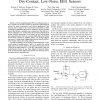Free Online Productivity Tools
i2Speak
i2Symbol
i2OCR
iTex2Img
iWeb2Print
iWeb2Shot
i2Type
iPdf2Split
iPdf2Merge
i2Bopomofo
i2Arabic
i2Style
i2Image
i2PDF
iLatex2Rtf
Sci2ools
ISCAS
2008
IEEE
2008
IEEE
A brain-machine interface using dry-contact, low-noise EEG sensors
Abstract— Electroencephalograph (EEG) recording systems offer a versatile, non-invasive window on the brain’s spatiotemporal activity for many neuroscience and clinical applications. Our research aims to improve the convenience and mobility of EEG recording by eliminating the need for conductive gel and creating sensors that fit into a scalable array architecture. The EEG drycontact electrodes are created with micro-electrical-mechanical system (MEMS) technology. Each channel of our analog signal processing front-end comes on a custom-built, dime-sized circuit board which contains an amplifier, filters, and analog-to-digital conversion. A daisy-chain configuration between boards with bitserial output reduces the wiring needed. A system consisting of seven sensors is demonstrated in a realworld setting. Consuming just 3 mW, it is suitable for mobile applications. The system achieves an input-referred noise of 0.28 µVrms in the signal band of 1 to 100 Hz, comparable to the best ...
Brain’s Spatiotemporal Activity | EEG Drycontact Electrodes | EEG Recording | Hardware | ISCAS 2008 |
| Added | 31 May 2010 |
| Updated | 31 May 2010 |
| Type | Conference |
| Year | 2008 |
| Where | ISCAS |
| Authors | Thomas J. Sullivan, Stephen R. Deiss, Tzyy-Ping Jung, Gert Cauwenberghs |
Comments (0)

